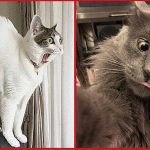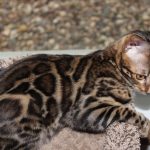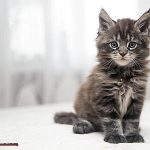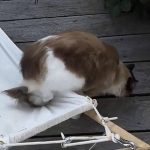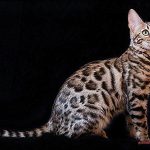As cat lovers, we adore our furry companions and their quirky behaviors. But, when your cat starts chomping down on another cat’s fur, it can leave you feeling perplexed and worried. So, why does your cat eat your other cat’s fur?
At first glance, it may seem like a case of a bored or mischievous kitty with nothing better to do. However, there could be underlying reasons behind this strange behavior. It could be due to nutritional deficiencies, anxiety and stress levels, or even an underlying health issue.
Whether your cat is the one doing the eating or being nibbled on, it’s crucial to understand the root cause of this behavior. In this blog post, we’ll dive into the various reasons why cats eat each other’s fur. We’ll explore the dietary needs of cats and how they relate to their behavior, as well as how stress and anxiety can affect their actions.
Additionally, we’ll discuss possible medical conditions that could be causing this behavior and what you can do to help your feline friend. Whether you’re a new pet owner or a seasoned cat parent, understanding why cats exhibit certain behaviors can help you provide better care for your furry companion.
So buckle up and get ready to explore the mysterious world of feline behavior as we uncover why cats eat each other’s fur.
What is Fur-Chewing or Fur-Eating?
This behavior occurs when a cat chews or eats its own fur or the fur of another cat. It is important to understand why cats engage in this behavior, as it can lead to several health problems such as hairballs, digestive issues, and even intestinal blockages.
There are several reasons why a cat may start chewing or eating fur. For instance, stress or anxiety is one of the most common causes. Changes in their environment or routine can cause cats to feel anxious, and they may start chewing on the fur of other cats as a way to alleviate their anxiety.
Boredom or lack of stimulation is another reason that can lead to fur-chewing behavior. Cats are natural hunters, and if they do not have enough mental or physical stimulation, they may resort to destructive actions like fur-chewing.
Medical issues such as allergies or skin irritations can also be a reason for this behavior. In these cases, cats may chew on their own fur or that of other cats as a way to alleviate their discomfort.
Nutritional deficiencies can also lead to fur-chewing behavior. If a cat’s diet lacks essential nutrients like protein, it may result in this behavior.
It is essential to address this behavior as it could lead to several health problems such as hairballs, digestive issues, and even intestinal blockages. It can also cause bald patches on the cat’s coat, making it look unsightly.
As a responsible pet owner, it is vital to observe your cat’s behavior closely and consult with a veterinarian if you notice any concerning symptoms. Providing enough mental and physical stimulation, ensuring a balanced diet and reducing stress factors are all great ways to prevent fur-chewing behavior in your furry friend.

Reasons Why Cats Eat Other Cats’ Fur

Cats are fascinating creatures, and while they spend a lot of time grooming themselves, sometimes they turn their attention to their feline housemates. This can lead to the consumption of fur, which can be concerning for pet owners. As an expert on this topic, I can tell you that there are several reasons why cats may eat other cats’ fur, and it’s essential to understand these reasons to address any underlying issues.
Stress and anxiety are common reasons why cats may start chewing on the fur of other cats. Cats are sensitive animals and can become stressed or anxious due to various factors such as changes in their environment, routine, or the introduction of a new pet. In response, they may turn to excessive grooming and even consume the fur. This behavior can lead to hair loss and even serious health issues such as intestinal blockages. To prevent this behavior, identify any potential stressors in your cat’s environment and provide them with extra attention and comfort.
Boredom is another reason why cats may eat other cats’ fur. Cats are natural hunters and require mental stimulation to stay active and healthy. When they lack opportunities for play and exploration, they may engage in destructive behaviors like fur-chewing. Provide your cat with interactive toys and scratching posts to keep them mentally stimulated. This will not only prevent the consumption of fur but also contribute to their overall well-being.
Medical issues can also be a reason why cats eat other cats’ fur. Skin allergies, parasites, or other skin conditions can cause itching and discomfort in cats, leading them to groom excessively and consume fur in the process. Additionally, some medical conditions such as hyperthyroidism or gastrointestinal disorders can also cause excessive grooming and ingestion of fur. If you suspect your cat has a medical issue, take them to the vet for an evaluation.
Stress and Anxiety
But just like humans, cats can experience stress and anxiety, which can lead to behavioral issues that affect their physical and emotional well-being. As an expert on this topic, I have researched effective ways to prevent and address stress and anxiety in cats.
Firstly, it’s important to create a safe and comfortable environment for your cat. Cats are territorial animals, and they need a space where they feel secure. Providing plenty of hiding places, scratching posts, and perches for them to climb on can help reduce their stress levels. Additionally, keeping a consistent routine for feeding times and litter box cleanings can provide a sense of stability.
Identifying the root cause of your cat’s stress or anxiety is also crucial to addressing the issue effectively. Excessive grooming or hair loss may be signs of stress or anxiety in your cat. If you have multiple cats, keep an eye out for aggressive behavior such as grooming or biting other cats’ fur. These behaviors may stem from social anxiety or territorial issues.
If environmental changes do not improve your cat’s behavior, it may be necessary to consult with a veterinarian or professional animal behaviorist. They can help identify any underlying medical or behavioral issues and recommend appropriate treatment options.
In some cases, medication may be necessary to manage your cat’s anxiety and stress levels effectively. However, medication should always be used as a last resort and under the guidance of a veterinarian.
Boredom and Lack of Stimulation

This seemingly harmless behavior can actually be a sign of boredom and lack of stimulation.
Cats are naturally curious and playful creatures, and when they lack entertainment, they may resort to grooming their housemates excessively. Over time, this behavior can turn dangerous as it can lead to the ingestion of fur, which is unsanitary and poses health risks.
As responsible pet owners, we must take steps to prevent this behavior. Here are some tips:
Plenty of Toys and Playtime: Cats love toys, so provide them with a variety of options to keep them engaged. Interactive toys that require problem-solving skills are particularly great for stimulating your cat’s mind.
Scratching Posts: Scratching is an instinctive behavior for cats, so make sure they have access to scratching posts to avoid destructive scratching on your furniture.
Interactive Games: There are plenty of interactive games available that can keep your cat entertained for hours. Try hiding treats around the house or playing hide-and-seek with your furry friend.
Comfortable Environment: Make sure your cat has a comfortable environment that allows them to relax and destress. Provide plenty of hiding places and cozy beds where they can retreat when they need alone time.
If you notice excessive grooming or fur-eating behaviors in one of your cats, it’s important to intervene immediately. Distract them with toys or treats or separate them from their housemates until they calm down. If the behavior persists, consult with a veterinarian or animal behaviorist for further guidance.

Underlying Medical Issues
If you notice your cat eating their own or another cat’s fur, it could be a sign of underlying medical issues. It’s important to take them to the veterinarian to rule out any potential conditions that could be causing this behavior.
One possible medical issue that may lead to this behavior is pica. Pica is a condition where cats eat non-food items such as fur, wool, or plastic. This could be caused by anemia, vitamin deficiencies, gastrointestinal disorders, or even stress and anxiety. Treatment for pica involves addressing the underlying medical condition and providing appropriate dietary supplements such as vitamins and minerals.
Another possible medical condition is hyperthyroidism. This occurs when the thyroid gland produces an excessive amount of thyroid hormone, leading to increased appetite and weight loss. Hyperthyroidism can be diagnosed through blood tests and treated with medication or surgery.
Excessive grooming may also cause cats to eat their own fur. This behavior could be a sign of underlying skin conditions such as allergies or parasites. Treatment for these conditions may involve medication or changes in diet.
To ensure your cat receives proper care, it’s crucial to take them to the veterinarian if you notice any unusual behavior like fur-eating. The vet will perform a thorough examination and run diagnostic tests if needed. Treatment may involve addressing any medical issues with medication or dietary supplements.
Signs of Fur-Chewing or Fur-Eating in Cats
However, excessive grooming can be a sign of fur-chewing or fur-eating in cats. This condition can have various causes, including stress, anxiety, boredom, and medical issues. Therefore, it’s crucial to recognize the signs of fur-chewing or fur-eating in cats to prevent further complications.
One of the most apparent signs of fur-chewing or fur-eating in cats is bald patches on the skin. These patches are usually found on the stomach, legs, and hindquarters and can be an indication that your cat is excessively licking and chewing its own fur. It’s important to examine these patches carefully for any signs of inflammation or infection, as they can cause discomfort and pain for your cat.
Another sign of fur-chewing or fur-eating in cats is excessive grooming. If you find your cat spending an unusual amount of time grooming itself, it could be a sign of an underlying medical condition or stress. You should monitor your cat’s grooming habits closely to determine if they become obsessive or compulsive, which can lead to further health problems.
Vomiting hairballs is another symptom of fur-chewing or fur-eating in cats. Hairballs occur when a cat ingests too much fur while grooming itself. While occasional hairballs are normal, frequent vomiting could be a sign that your cat has an underlying medical issue that needs to be addressed by a veterinarian.
How to Reduce the Risk of Your Cat Eating Other Cats’ Fur
Cats are known for their grooming habits, but sometimes it can go too far and lead to fur-chewing behavior. This behavior can be caused by various factors, including stress, boredom, and underlying medical issues. As a responsible cat owner, it’s important to reduce the risk of your cat eating other cats’ fur to prevent serious health issues.
Provide Mental and Physical Stimulation
Boredom can lead to excessive grooming and fur-eating behavior. Providing interactive toys, scratching posts, and playtime can keep your cat entertained and engaged. This will also prevent them from turning to grooming as a way to pass the time.
Create a Peaceful Environment
Fighting among cats can lead to anxiety and stress, which can trigger fur-eating behavior. By providing each cat with separate resources such as food bowls and litter boxes, you can avoid conflicts between cats. Additionally, providing hiding spots or perching areas for each cat can help them feel safe and secure.
Regular Grooming
Regular grooming can help remove loose fur and prevent your cat from ingesting it while grooming themselves. This will also promote healthy skin and coat.
Check for Underlying Medical Issues
If you notice excessive grooming in one of your cats, it may be a sign of an underlying medical issue that requires veterinary attention. It’s important to monitor your cat’s behavior and seek professional help if necessary.
Provide a Nutritious Diet
A poor diet can lead to dry and itchy skin, triggering excessive grooming and fur-eating behavior. Consult with your veterinarian on the best diet for your cats based on their age, weight, and health condition.
Professional Help for Your Cat’s Behavior Problem
If you’ve noticed any unusual or problematic behavior, such as excessive grooming or aggression towards other cats, seeking professional help is crucial. A trained behaviorist or veterinarian can help identify the root cause of the behavior and provide appropriate solutions for your cat’s well-being.
Why is it so important to seek professional help for your cat’s behavior problem? Here are some compelling reasons:
Identifying the root cause: Behavior problems in cats can stem from a variety of factors, including medical issues, environmental stressors, or even genetics. A qualified professional will conduct a thorough assessment to determine the underlying cause of your cat’s behavior and develop a customized treatment plan.
Choosing the right professional: When selecting a professional, look for someone with specialized knowledge in feline behavior and a proven track record of success. This will ensure that your cat receives the best possible care and treatment.
Preparation is key: Before scheduling an appointment with a behaviorist or veterinarian, make a list of questions and concerns to discuss during your visit. Be sure to provide detailed information about your cat’s behavior to help the professional better understand the problem at hand.
Follow-through: Implementing changes to modify your cat’s behavior requires patience and consistency. Be prepared to follow through with any recommendations or advice provided by the professional and know that it may take time for improvements to occur.
_FOVEqT8d7I” >
Conclusion
After exploring the various reasons why cats may eat their fellow feline’s fur, it is clear that this behavior can be a sign of underlying issues such as stress, boredom, or medical conditions. As pet owners, we must take responsibility and address the root cause to prevent potential health problems like hairballs and digestive issues.
To keep our cats engaged and entertained, providing them with interactive toys, scratching posts, and regular playtime is key. It’s also important to create a peaceful environment for each cat by offering separate resources and avoiding conflicts between them.
Regular grooming can help maintain healthy skin and coat while reducing the amount of loose fur available for consumption. However, if you notice your cat exhibiting excessive fur-chewing behavior, it’s crucial to seek professional help from a trained behaviorist or veterinarian who can develop a customized treatment plan.
By understanding why our cats exhibit certain behaviors and taking proactive steps to address them, we can ensure their overall well-being and reduce the risk of fur-eating behavior in multi-cat households.

